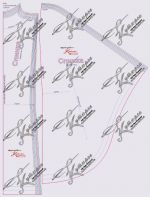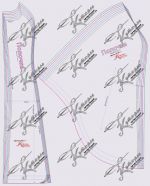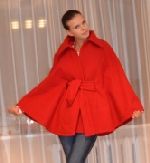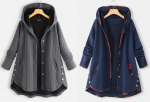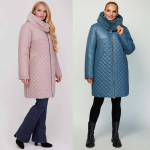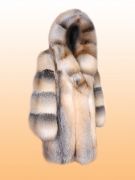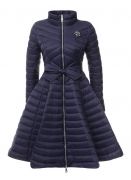Size charts What is the height of the pattern Payment methods Ask a question Reviews
PDF pattern for printing on a printer or plotter in full size for cape sizes from 40 to 62. All sizes are printed from one file. Sheets of paper from A4 to A0.
 Free download Instructions on how to sew this cape pattern
Free download Instructions on how to sew this cape pattern

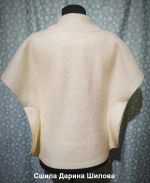 In the photo, see a variant of a sewn cape according to this pattern from the customer Darina Shilova:
In the photo, see a variant of a sewn cape according to this pattern from the customer Darina Shilova:
"Wedding poncho according to the Cape pattern with a one-piece stand. Thanks for the patterns! Size 54, coat fabric bouclé, in the pattern I changed the length of the shoulder seam and the overall length of the product. There is no photo on the figure yet. It was sewn remotely to order for a wedding dress."
How to sew a cape with a tailored shoulder line and a one-piece stand with your own hands
Contents of the instruction:
- Description of the cape pattern and style.
- How to download a cape pattern.
- Do-it-yourself pattern of a cape-cape with a one-piece stand.
- How to sew a cape cape step by step.
Download the finished cape pattern
Description of the pattern and style, consumption and choice of fabric for sewing a cape
Description:
Electronic cape pattern - cape with one-piece stand 40-62
Sizes: 40-62 (the buyer receives all sizes of the selected gradation)
File format for download in order:
PDF in full size and without seam allowances.
After paying for the order, you will receive links to download two files cape patterns gradation of sizes from 40 to 62:
- PDF file A4, adapted for printing patterns on sheets of A4 paper in any program on any device, including mobile phones.
- Multi-format PDF file for printing on sheets of any size from A0 to A4 on a printer or plotter using Adobe Reader.
Sewing difficulty level: medium - the product will require skills in working with coat fabrics.
Cape pattern set
Curves of the pick, facing of the sprout and lining are not included in the kit, since these parts are cut out according to the patterns of the back and shelves.
Style and fabric consumption
Please note that the shape of the edge prevents the shelves from moving apart even if the balance of the product is disturbed. That is why this style is suitable for everyone, even the most incredible figures of any height. The silhouette is free.
The consumption of fabric for sewing this cape model with a width of 140 - 150 cm will be up to 280 cm, depending on the size.
Lining fabric consumption: up to 190 cm, with a width of at least 140 cm.
The consumption of dublerin is equal to the length of the part of the middle part of the shelf.
What to sew a cape from - a cape with a one-piece stand
The ideal choice in this case would be a soft, but fairly dense fabric.
Fabrics that are easily deformed should be avoided.
Loden and boucle are well suited for sewing this model. Of course, dubbing is required.
A lightweight drape is also good.
If your choice fell on tweed, then it should be approached selectively. For example, Chanel tweed can be very deformed in the sock and this must be taken into account.
As for pile fabrics, it is desirable to sew from them only for those couturiers who have experience and skills in tailoring outerwear.
Instructions for buying and printing patterns in PDF format with your own hands
How to buy and download a cape pattern...
How to print a pattern in full size on sheets of A4 - A0 ...
How to choose a pattern size without taking measurements and using tables
Full-size ready-made patterns free download in pdf format
Buy and download this cape pattern - cape
Do-it-yourself pattern of a cape - a cape with a one-piece stand
![]() It would seem, “what to sew there!”, If there is a full-size pattern and you don’t need to “sew on a sleeve”. However, the home couturier will face numerous challenges, starting with fabric selection and seam allowances.
It would seem, “what to sew there!”, If there is a full-size pattern and you don’t need to “sew on a sleeve”. However, the home couturier will face numerous challenges, starting with fabric selection and seam allowances.
The choice of size for this model is not very difficult. More difficult with the choice of length. You should be guided both by the finished product and by the measurement from the side point of the neck to the wrist along the bent elbow.
Seam allowances
Add 1 cm along the seams of the reliefs and along the shoulder seams (picture 2). On the bottom 2,5 - 3 cm.
Along the edge of the side of the middle part of the shelf - 0,7 - 1 cm, and for the part of the selection, the allowances should be less - 0,5 - 0,7. Why such a difference in allowances? In order to make the so-called edging from the upper part, that is, from the shelf.
To make it easier for ourselves with allowances, first we cut out the selection, and then, according to the details of the selection, a shelf. And the thicker the fabric, the greater should be the difference between the allowances for the selection and for the middle part of the shelf along the cut of the side.
The same can be said about the allowance for the facing for the sprout, or rather the facing for the one-piece rack.
 To cut the facing and back lining, we cut the pattern of the middle part of the back along the marking line in the drawing (picture 3).
To cut the facing and back lining, we cut the pattern of the middle part of the back along the marking line in the drawing (picture 3).
The allowance for turning from the side of the lining is 1 cm.
Lining allowances - 1 cm everywhere except the bottom. For the bottom we leave more - 5 - 7 cm.
How to cut a cape: layout
The fabric is folded in half face to face, the edges are aligned and placed parallel to the edge of the cutting table.
Patterns are laid out taking into account the share direction, which is indicated on the drawings. Separately, it is worth mentioning the share direction of the selection and the middle part of the shelf.
In the selection, the share can be located arbitrarily along the part, and in the middle part of the shelf parallel to the semi-skid.
Due to the smell expanding towards the bottom, the edge of the bead is on an oblique thread, but you should not worry about the fact that the bead will stretch during wear - the volume of the product is large, there is no fastener on the buttons.
The expanding smell of the cape will allow the product not to diverge, even on the owners of large breasts and protruding belly. "Apples", suffering from divergent sides, can safely choose the pattern of this model.
Cutting the lining is not difficult, we lay out the patterns in the most economical way.
How to sew a cape - cape step by step
Sewing a cape, like other outerwear with individual tailoring, comes down to three stages:
- Assembling the "top" of the cape
- Fitting
- Cape lining assembly
- Connecting top and lining
When assembling the "top", the most important issue is WTO - wet-heat treatment of the product. Of course, modern fabrics containing synthetics or consisting entirely of it will not require very much effort to steam and set ironed seams, but you should still follow the basic rules of ironing:
- We decant the fabric before cutting - carefully iron with plenty of steam
- We duplicate the pick and turn, and in loose fabrics we also duplicate the shoulder area (where the shoulder pad is)
- Carefully iron each seam after each line.
So, we start assembling the “top” of the product with the WTO and continue by grinding and ironing the seams. It is only necessary to take into account that basting in this case is necessary, especially if you grind seams on a household sewing machine.
An important point is the definition of spacers for threading the belt. Spreaders are best done both on the shelf and on the back. Thus, the belt will be visible on the middle part of the shelf and on the middle part of the back.
The position of the spacers is best clarified by fitting.
Let me remind you that the fitting should be carried out with shoulder pads and a belt.
The assembly of the “top” of this model also includes the processing of the sides. First, the bead is connected to the facing, the seams are ironed out, and then the bead is turned.
A few more words about duplication. It is very important to duplicate the facing well. Additional dubbing directly above the seam of the connection of the backrest with the lining will not hurt either. If the strut is stretched, the entire cape will deform. Additional dubbing should not be stretched.
Assembling the lining is perhaps the easiest operation. Internal pockets are processed at desire.
And how to connect the "top" with the lining. In principle, the cape can be sewn without lining. Open sections in this case are edged.
The lining, if any, is best done "closed", as in men's clothing. Otherwise, there is a risk that it will be visible from under the cape.
The connection sequence is as follows.
Connect the lining along the pick and turn, connect the cut of the pick-lining with the "top" with hidden stitches.
Attach the lining to the "top" in the area of the shoulder seams in the area above the elbow and above the waist (sections 10 - 12 cm long), fasten in the spacer area.
Bend and sweep the lining along the bottom, connect the bottom seam with the "top" through the hole in any of the seams. Sew up the hole.
Download this pattern pdf:
Cape pattern with one-piece stand
$1.50 (60 hryvnia)
Bank cards of the Russian Federation are not accepted for payment!
Size charts What is the height of the pattern Payment methods Ask a question Reviews
Vera Olkhovskaya in social networks:

-
Any pattern for free for a review of a previously made order
More...
Lifetime promotion for buyers of patterns!

Leave a review about my store of patterns for an order that you made before, and you will receive any paid pattern of your choice Free!

 Download this cape pattern
Download this cape pattern